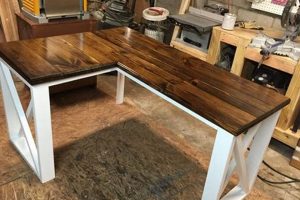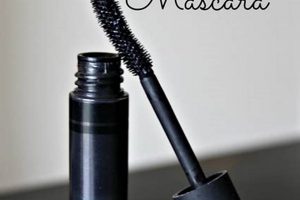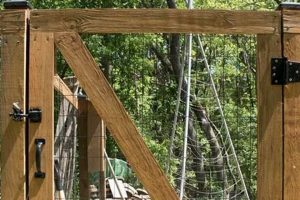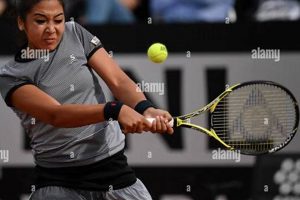The creation of custom-built habitats for Pogona vitticeps represents a growing trend among reptile enthusiasts. This approach involves constructing a living space tailored to the specific needs of the animal, often diverging from commercially available options. Such endeavors typically necessitate careful planning, the selection of appropriate materials, and adherence to established standards of reptile husbandry.
Constructing personalized environments for these reptiles allows for enhanced control over environmental parameters such as temperature gradients, humidity levels, and UVB exposure. This customization can lead to improved animal welfare by better replicating the animal’s natural habitat. Historically, keepers relied solely on manufactured enclosures, but increasing accessibility to information and resources has fueled the rise of individualized construction projects.
The subsequent discussion will explore vital considerations for undertaking such a project, including material selection, structural design, ventilation strategies, thermal regulation implementation, and safety precautions to ensure a healthy and secure environment for the reptile.
Guidance for Custom Reptile Habitat Construction
Consider the following recommendations to facilitate the successful and safe creation of a personalized living space for Pogona vitticeps.
Tip 1: Material Selection: Opt for non-toxic materials resistant to heat and moisture. Melamine, sealed plywood, or PVC boards are frequently employed. Avoid untreated wood due to its susceptibility to bacterial and fungal growth.
Tip 2: Size and Dimensions: Ensure adequate space for the animal to thermoregulate effectively. A minimum size of 4ft x 2ft x 2ft (length x width x height) is recommended for adult specimens to facilitate proper temperature gradients.
Tip 3: Ventilation Implementation: Proper airflow is crucial to prevent respiratory issues. Incorporate ventilation holes or mesh panels on opposing sides of the structure to promote adequate air exchange while minimizing heat loss.
Tip 4: Thermal Gradient Establishment: Implement a basking zone with a surface temperature between 100-110F (38-43C) using appropriate heating elements. A cooler zone should maintain a temperature range of 75-85F (24-29C). Use a reliable thermostat to regulate heating elements precisely.
Tip 5: Substrate Considerations: Choose a safe and easily cleanable substrate. Solid substrates such as reptile carpet or tile are often favored due to their ease of sanitation and reduced risk of impaction compared to particulate substrates like sand.
Tip 6: Security and Safety: Ensure the enclosure is secure to prevent escape. Use reliable latches or locks on doors. All electrical components must be properly grounded and shielded to prevent electrical shock.
Tip 7: Lighting Considerations:Provide adequate UVB and UVA lighting to promote healthy bone growth and overall well-being. Replace UVB bulbs regularly according to manufacturer recommendations, as UVB output diminishes over time.
Adhering to these guidelines will contribute significantly to the health, safety, and welfare of the reptile within its custom-built habitat.
The subsequent section will address the legal and ethical implications associated with keeping Pogona vitticeps and constructing individualized habitats.
1. Enclosure Size
The dimensional parameters of a Pogona vitticeps habitat, particularly within the context of individualized construction, significantly influence the animal’s physiological and behavioral well-being. Insufficient enclosure volume directly restricts the reptile’s capacity for natural behaviors such as locomotion, exploration, and thermoregulation. This limitation can lead to chronic stress, suppressed immune function, and an increased susceptibility to illness. A habitat built without adequate dimensions, despite other optimized features, fundamentally undermines the potential benefits of a custom-designed environment. For instance, an adult Pogona vitticeps requires a minimum of 48″x24″x24″ to establish a proper temperature gradient and engage in necessary physical activity.
Conversely, incorporating ample space into the habitat design fosters a more stimulating and healthy environment. Increased area permits the creation of diverse microclimates, encouraging natural basking behaviors and facilitating effective thermoregulation. Furthermore, a larger enclosure provides opportunities for enrichment through the introduction of climbing structures, hides, and varied substrates, thereby mitigating boredom and promoting cognitive stimulation. As a specific example, an enclosure exceeding the minimum dimensions allows for the creation of distinct basking and cooling zones, allowing the animal to select its preferred temperature as needed.
Therefore, enclosure size is not merely a quantifiable specification but a crucial determinant of the overall success of a self-constructed reptile habitat. A design prioritizing adequate dimensions is fundamental to fostering an environment conducive to the long-term health and welfare of the animal, highlighting the importance of adhering to established size guidelines and, when feasible, exceeding them to enhance the reptile’s quality of life.
2. Thermal Regulation
Effective thermal regulation constitutes a critical component within individualized reptile habitats, directly influencing the physiological well-being of Pogona vitticeps. These reptiles, being ectothermic, rely on external heat sources to maintain their internal body temperature, impacting metabolic processes, digestion, and immune function. Inadequately designed or controlled thermal gradients within custom enclosures can lead to a cascade of negative health consequences, including anorexia, lethargy, and increased susceptibility to infection. For example, a habitat lacking a sufficient basking zone will prevent the animal from reaching its optimal body temperature, hindering proper digestion and nutrient absorption. Conversely, a habitat lacking a cooler zone can result in overheating and hyperthermia, potentially leading to organ damage.
The implementation of appropriate heating elements, coupled with precise temperature monitoring and control, is paramount. Utilizing a thermostat-controlled ceramic heat emitter or basking lamp to establish a basking zone with a surface temperature between 100-110F (38-43C) is a common practice. A separate, cooler zone should be maintained at 75-85F (24-29C) to allow the reptile to thermoregulate effectively. The strategic placement of hides and dcor within both the warm and cool zones provides additional opportunities for the animal to modulate its body temperature. Regular monitoring of temperatures within various areas of the enc
losure, using digital thermometers or infrared temperature guns, is crucial to ensure stability and consistency. Moreover, it is necessary to consider the thermal properties of the chosen enclosure materials, as certain materials may retain heat more readily than others, impacting the overall thermal gradient.
In summary, thermal regulation constitutes a non-negotiable aspect of the design and management of individualized reptile habitats. Failure to provide a properly controlled thermal gradient can have profound implications for the animal’s health and well-being. A comprehensive understanding of the reptile’s thermal needs, coupled with the careful selection of heating equipment and diligent monitoring, is essential for creating a safe and functional environment that promotes the animal’s long-term health and welfare. Furthermore, consideration must be given to the integration of failsafe mechanisms, such as backup heating elements or temperature alarms, to mitigate the risks associated with equipment malfunction or power outages.
3. Ventilation
Adequate ventilation is a critical, yet often overlooked, factor in the design and functionality of custom-built Pogona vitticeps habitats. Air exchange within the enclosure directly impacts the reptile’s respiratory health, the maintenance of appropriate humidity levels, and the prevention of harmful bacterial and fungal growth. Insufficient airflow can result in a stagnant environment, predisposing the animal to respiratory infections and compromising its overall well-being.
- Gas Exchange Optimization
Ventilation facilitates the removal of stale air, laden with carbon dioxide and other metabolic byproducts, and the introduction of fresh, oxygen-rich air. This process is essential for supporting the reptile’s respiratory function and preventing the buildup of potentially harmful gases. For example, sealed enclosures without adequate ventilation can lead to elevated carbon dioxide levels, causing respiratory distress and potentially compromising the animal’s immune system. The placement of ventilation ports on opposing sides of the enclosure promotes cross-ventilation, maximizing gas exchange efficiency.
- Humidity Control
Proper ventilation plays a key role in regulating humidity levels within the enclosure. Excessive humidity can create an environment conducive to bacterial and fungal growth, increasing the risk of skin infections and respiratory problems. By promoting air circulation, ventilation helps to dissipate excess moisture, maintaining a more stable and healthy humidity range. The size and placement of ventilation openings should be carefully considered to balance humidity control with the need to maintain appropriate temperature gradients.
- Odor Mitigation
Ventilation aids in the removal of odors associated with waste products and decaying food. The buildup of these odors can create an unpleasant environment for both the reptile and its keeper and may also indicate the presence of harmful bacteria or fungi. Adequate airflow helps to dissipate these odors, contributing to a cleaner and more hygienic environment. The integration of a small, reptile-safe fan can further enhance odor control.
- Temperature Gradient Support
While often considered separately, ventilation can also influence the establishment and maintenance of appropriate temperature gradients within the enclosure. Proper airflow helps to prevent the formation of stagnant hot spots, ensuring a more uniform distribution of heat. This is particularly important in larger enclosures where temperature stratification can occur. The placement of ventilation openings should be strategically planned to avoid disrupting the intended thermal gradient.
The design and implementation of an effective ventilation system are crucial for the long-term health and well-being of Pogona vitticeps within custom-built enclosures. A well-ventilated habitat promotes gas exchange, controls humidity, mitigates odors, and supports temperature gradients, all of which contribute to a healthier and more enriching environment for the reptile. Careful consideration should be given to the size, placement, and type of ventilation openings to ensure optimal airflow while minimizing potential negative impacts on temperature and humidity control.
4. Substrate Safety
Substrate selection within custom-built Pogona vitticeps enclosures is a critical determinant of reptile health, directly impacting the risk of impaction and exposure to pathogens. Impaction, the blockage of the digestive tract by ingested materials, is a significant concern, particularly with particulate substrates. Inappropriately chosen or improperly managed substrates can lead to severe health consequences, including death. The construction of individualized habitats necessitates a thorough understanding of substrate-related risks and the implementation of preventative measures.
Solid substrates, such as reptile carpet or tile, represent a safer alternative to particulate options. These materials are non-ingestible and easily sanitized, minimizing the risk of impaction and reducing the potential for bacterial growth. For example, loose substrates like sand or wood shavings, while aesthetically appealing to some keepers, can be accidentally ingested during feeding or normal exploratory behavior. Over time, the accumulation of these materials within the digestive tract can lead to a blockage, necessitating veterinary intervention or, in severe cases, proving fatal. Substrate safety, therefore, is not merely a matter of aesthetic preference but a fundamental consideration in reptile husbandry.
Choosing appropriate substrates within the framework of individualized enclosure construction demands prioritizing reptile health and safety. By selecting non-particulate options and implementing rigorous sanitation protocols, the risks associated with impaction and pathogen exposure can be significantly mitigated. The practical significance of this understanding lies in the prevention of potentially life-threatening conditions, contributing to the long-term well-being of the reptile and reinforcing responsible pet ownership.
5. Lighting Spectrum
The provision of an appropriate lighting spectrum represents a non-negotiable element within the design and construction of Pogona vitticeps enclosures. As diurnal reptiles, Pogona vitticeps rely on specific wavelengths of light for crucial physiological processes, including vitamin D3 synthesis, calcium absorption, and the regulation of circadian rhythms. Individualized habitat construction necessitates a comprehensive understanding of these requirements to ensure the animal’s long-term health and well-being.
- UVB Radiation and Vitamin D3 Synthesis
Ultraviolet B (UVB) radiation is essential for the synthesis of vitamin D3 in the reptile’s skin. Vitamin D3 plays a critical role in calcium absorption, preventing metabolic bone disease (MBD), a debilitating condition characterized by weakened bones and skeletal deformities. In the context of individualized habitat construction, selecting UVB-emitti
ng bulbs with the appropriate intensity and spectrum is paramount. The distance between the bulb and the basking area must be carefully considered, as UVB intensity decreases with distance. Inadequate UVB exposure inevitably leads to vitamin D3 deficiency and subsequent calcium metabolism disorders. - UVA Radiation and Behavioral Regulation
Ultraviolet A (UVA) radiation, while not directly involved in vitamin D3 synthesis, contributes significantly to the reptile’s behavioral regulation. UVA wavelengths are visible to Pogona vitticeps and influence feeding behavior, activity levels, and social interactions. The inclusion of UVA-emitting bulbs within the enclosure encourages natural behaviors and promotes overall psychological well-being. The absence of UVA radiation can result in lethargy, reduced appetite, and impaired reproductive behavior.
- Visible Light and Diurnal Rhythm Entrainment
Visible light, encompassing a broad spectrum of wavelengths, is crucial for entraining the reptile’s diurnal rhythm, the 24-hour cycle of activity and rest. Providing a consistent photoperiod, typically 12-14 hours of light followed by 10-12 hours of darkness, regulates hormone production, sleep patterns, and overall health. The intensity and duration of visible light should mimic natural conditions to promote optimal physiological function. The use of timers to automate lighting cycles ensures consistency and minimizes disruption to the reptile’s diurnal rhythm.
- Full Spectrum Lighting and Color Perception
The integration of full-spectrum lighting, which approximates the spectral composition of natural sunlight, can enhance the reptile’s color perception and contribute to a more naturalistic environment. While not as critical as UVB and UVA radiation, full-spectrum lighting can improve the aesthetic appeal of the enclosure and potentially stimulate natural behaviors. The choice of lighting fixtures should prioritize those that emit a balanced spectrum of wavelengths, avoiding excessive blue or red light, which can distort color perception and potentially cause eye strain.
In summary, the careful selection and implementation of lighting systems within individualized Pogona vitticeps enclosures necessitate a thorough understanding of the reptile’s specific spectral requirements. Providing adequate UVB and UVA radiation, along with appropriate visible light, is essential for promoting vitamin D3 synthesis, regulating behavior, and entraining the diurnal rhythm. Prioritizing these considerations during the construction phase contributes significantly to the reptile’s long-term health, welfare, and overall quality of life.
Frequently Asked Questions
The following addresses common inquiries regarding the design and construction of individualized enclosures for Pogona vitticeps, providing evidence-based guidance for responsible reptile keeping.
Question 1: What is the minimum acceptable enclosure size for an adult Pogona vitticeps in a custom-built habitat?
The minimum acceptable enclosure size for a single adult Pogona vitticeps is 48 inches in length, 24 inches in width, and 24 inches in height. This size provides adequate space for thermoregulation, exercise, and the establishment of appropriate environmental gradients. Smaller enclosures are detrimental to the reptile’s well-being.
Question 2: Which materials are deemed safe for use in custom reptile enclosure construction?
Acceptable materials include melamine, sealed plywood, PVC boards, and glass. All materials should be non-toxic, resistant to moisture, and easily sanitized. Untreated wood is not recommended due to its susceptibility to bacterial growth. Sealants and adhesives must be reptile-safe and fully cured before introducing the animal.
Question 3: How is adequate ventilation ensured in a custom-built reptile habitat?
Adequate ventilation requires the incorporation of ventilation ports or mesh panels on opposing sides of the enclosure to promote cross-ventilation. The size and placement of these openings should be carefully considered to balance airflow with the need to maintain appropriate temperature and humidity levels. Insufficient ventilation can lead to respiratory problems.
Question 4: What constitutes an appropriate thermal gradient within a Pogona vitticeps enclosure?
An appropriate thermal gradient necessitates a basking zone with a surface temperature of 100-110 degrees Fahrenheit (38-43 degrees Celsius) and a cooler zone maintained at 75-85 degrees Fahrenheit (24-29 degrees Celsius). This gradient allows the reptile to thermoregulate effectively and maintain its optimal body temperature. The use of a reliable thermostat is essential for precise temperature control.
Question 5: Which substrate options are considered safe for Pogona vitticeps in custom-built habitats?
Safe substrate options include reptile carpet, non-adhesive shelf liner, and ceramic tile. These solid substrates minimize the risk of impaction associated with particulate substrates like sand or wood shavings. Regular cleaning and disinfection are essential to prevent bacterial growth, regardless of the substrate chosen.
Question 6: What types of lighting are required in a custom Pogona vitticeps enclosure?
A Pogona vitticeps enclosure requires both UVB and UVA lighting. UVB lighting is essential for vitamin D3 synthesis and calcium absorption, while UVA lighting influences behavior and activity levels. The bulbs should be replaced regularly according to the manufacturer’s recommendations to ensure consistent UVB output. A separate heat lamp is also necessary to maintain the basking temperature.
Careful planning, proper material selection, and adherence to established husbandry practices are critical for constructing a safe and functional habitat. Prioritize the reptile’s health and well-being throughout the design and construction process.
The subsequent section will provide a guide on assessing the structural integrity of custom-built enclosures.
DIY Bearded Dragon Enclosures
This exploration of diy bearded dragon enclosure construction has underscored critical factors vital to the health and welfare of Pogona vitticeps. Aspects such as adequate enclosure dimensions, precise thermal regulation, effective ventilation, secure substrate selection, and appropriate lighting spectrum provision were examined to emphasize the importance of replicating the reptile’s natural environment within a captive setting. The implementation of these considerations contributes directly to the reptile’s physical and psychological well-being.
The construction of individualized habitats represents a significant commitment to responsible reptile keeping. Diligent application of the information presented herein will promote the creation of secure, functional, and enriching environments. Continued vigilance in monitoring and adapting the enclosure to the reptile’s evolving needs is paramount, ensuring the long-term health and vitality of the animal.







